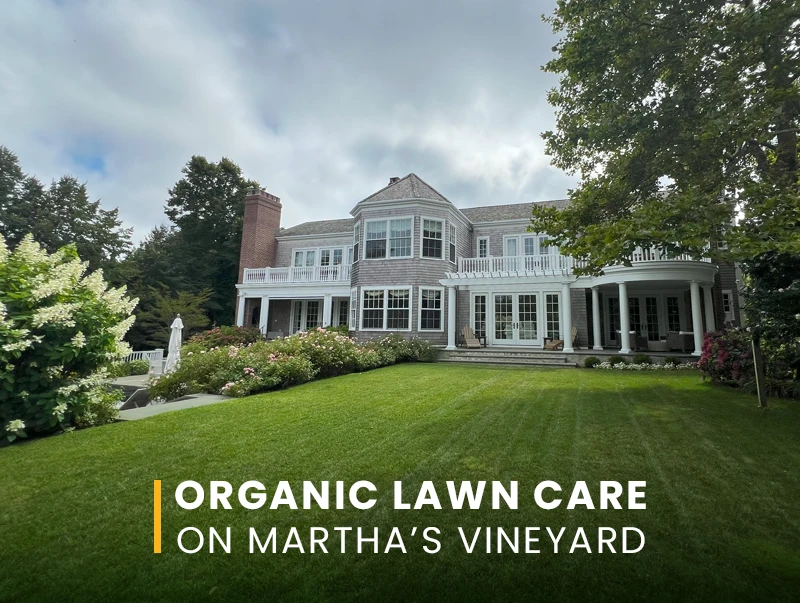Why “organic” fits Vineyard lawns
On Martha’s Vineyard, sandy, fast-draining soils, sea breeze, and summer droughts make turf care unique. Organic lawn care focuses on feeding the soil first, using slow-release, carbon-rich inputs and cultural practices that reduce weeds naturally—safer for kids, pets, wildlife, and the island’s coastal environment. Below is a practical, Vineyard-specific plan you can follow—or we can handle everything for you through our Lawn Care Services.
Soil Health & pH for Sandy Coastal Soils
- Test first, then treat. A soil test reveals pH, organic matter, and nutrient levels so you can dose precisely (many Vineyard lawns trend slightly acidic). We start every program with testing and a tailored plan.
- Build organic matter. Compost topdressing and organic fertilizers add carbon that improves nutrient retention and moisture holding—vital on sandy sites.
- Aim for the right pH. Most cool-season turf thrives around 6.3–6.7. If lime is needed, we apply it gradually and re-test.
- Microbial life matters. We avoid high-salt synthetics that can disrupt microbes and prefer inputs that encourage biology (humates, sea-based organics, compost).
Want a professional read on your soil? See our Lawn Fertilization Services.
Seasonal Feeding Plan (Island Calendar)
Early spring (soil warms): Light organic feed to “wake” biology without pushing weak, fast growth. Spot-seed winter damage if needed.
Late spring: Add slow-release organics and iron for color. Address pH adjustments per soil test.
Summer: Focus on soil health and stress management—humates, kelp, and light spoon-feeds if turf is irrigated; otherwise, let grass rest and mow higher.
Early fall (prime growth window): The cornerstone feeding. We pair an organic fertilizer with core aeration and overseeding where needed for thickening.
Late fall: Final organic feed to bolster roots and carbohydrate reserves heading into winter.
Watering & Mowing Heights that Reduce Weeds
- Watering: Deep and infrequent beats daily sprinkles. Target ~1 inch/week in season (including rain), applied in 1–2 soakings so water reaches roots.
- Mowing: Keep it high—generally 3–3.5″. Taller blades shade soil, conserve moisture, and suppress weed germination. Always use sharp blades and follow the ⅓-rule (never remove more than one-third of the blade at a time).
- Traffic management: After seeding or aeration, limit foot and pet traffic until seedlings are established.
Organic Weed Suppression (Without Blanket Herbicides)
- Thicken first. Dense turf is the best herbicide. We overseed thin patches, especially after aeration.
- Pre-emergent options. Corn gluten meal can reduce certain annual weeds when timed before germination (effectiveness varies with weather; we combine it with cultural practices).
- Post-emergent spot care. For broadleaf weeds, we hand-pull or use targeted, low-impact treatments. Consistent mowing heights and proper feeding do most of the heavy lifting.
- Bed edges & transitions. Crisp edges and mulch in beds reduce encroachment and create a clean, finished look.
Struggling with weeds now? Our Lawn Weed Control service prioritizes cultural fixes and spot-treatments to keep lawns kid- and pet-friendly.
What We Include (Estate Care’s Organic Program)
- Soil testing & plan: Baseline test, re-testing as needed, and a season-long schedule built for your property.
- Premium organic fertilizers: Slow-release, biology-friendly inputs tailored to your soil profile.
- Aeration + overseeding (as needed): Fall core aeration opens the soil; slit-seeding or broadcast seeding thickens turf.
- Topdressing & compost (where appropriate): Boosts organic matter and water-holding.
- Irrigation guidance: We calibrate run times and offer maintenance recommendations to avoid waste.
- Kid/pet-safe standards: Clear re-entry timelines and product transparency.
- Pro monitoring: We adjust timing with coastal weather patterns and provide photo updates for off-island owners.
Pricing & Timelines (What to Expect)
- Program pricing: Based on lawn size, soil needs, and whether aeration/overseeding/topdressing are included.
- Results timeline: Color and vigor typically improve within weeks; meaningful weed reduction and density gains often take one full growing season of consistent care.
- Upgrades: Irrigation tune-ups, bed edging, slice-seeding, and compost topdressing accelerate results.
Ready to Go Organic?
If you want a greener, safer lawn with fewer weeds and less waste, we’d love to help. Explore our Lawn Care Services or request a free quote and we’ll tailor a plan to your property.
FAQs
Is organic lawn care effective on Vineyard soils?
Yes – especially when paired with soil testing, correct pH, and fall overseeding. Sandy soils respond well to organic matter additions and slow-release feeding.
How long until I see results?
Expect improved color and resilience within weeks; thicker turf and fewer weeds typically emerge across one full growing season of consistent practices.
What mowing height reduces weeds?
Aim for 3–3.5″. Taller mowing shades the soil surface, conserving moisture and discouraging weed germination.
Are treatments pet and kid-safe?
We use organic inputs and provide re-entry guidance for peace of mind. We’ll share product details and timing before every visit.
Do you handle soil testing and adjustments?
Absolutely. We begin programs with a soil test and build your feeding/pH plan from those results.


